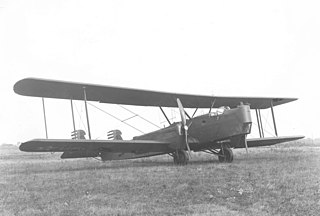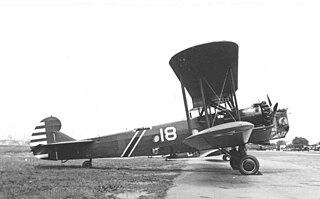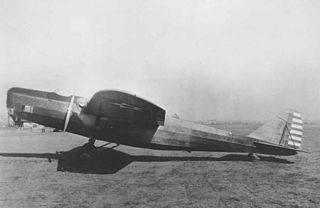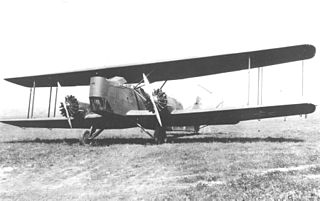
The Huff-Daland XB-1 was a prototype bomber aircraft built for the United States Army Air Corps.

The Keystone B-6 was a biplane bomber developed by the Keystone Aircraft company for the United States Army Air Corps.

The Douglas Y1B-7 was a 1930s American bomber aircraft. It was the first US monoplane given the B- 'bomber' designation. The monoplane was more practical and less expensive than the biplane, and the United States Army Air Corps chose to experiment with monoplanes for this reason. At the time the XB-7 was ordered, it was being tested by Douglas Aircraft as an observational plane.

The Fokker XB-8 was a bomber built for the United States Army Air Corps in the 1920s, derived from the high-speed Fokker O-27 observation aircraft.

The Boeing YB-9 was the first all-metal monoplane bomber aircraft designed for the United States Army Air Corps. The YB-9 was an enlarged alteration of Boeing's Model 200 Monomail commercial transport.

Huff-Daland was an American aircraft manufacturer. Formed as Ogdensburg Aeroway Corp in 1920 in Ogdensburg, New York by Thomas Huff and Elliot Daland, its name was quickly changed to Huff-Daland Aero Corp and then in 1925 it was changed again to Huff-Daland Aero Company with its main headquarters in Bristol, Pennsylvania. Huff-Daland produced a series of biplanes as trainers, observation planes, and light bombers for the U.S. Army and Navy.

The Curtiss T-32 Condor II was a 1930s American biplane airliner and bomber aircraft built by the Curtiss Aeroplane and Motor Company. It was used by the United States Army Air Corps as an executive transport.

The Curtiss Model R was a utility aircraft produced for the United States Army and Navy during World War I. It was a conventional, two-bay biplane with slightly staggered wings of unequal span. The aircraft was provided with two open cockpits in tandem and fixed tailskid undercarriage, but many were built for the Navy with twin floats replacing the wheels. During the course of the war, Model Rs were used for general liaison and communication duties, as well for observation, training, and as air ambulances. In practice, the Curtiss powerplants supplied with these aircraft proved insufficient and were mostly replaced with Liberty engines. The Navy's Model R-3 floatplane had extended-span, three-bay wings, and was intended for use as a torpedo bomber. Some of these were later fitted with wheeled undercarriage and transferred to the Army as bombers under the designation Model R-9.

The Grumman XSBF, also known by the company designation G-14, was an American biplane scout bomber developed by Grumman Aircraft for the United States Navy during the 1930s. Derived from Grumman's successful "Fifi" fighter, the aircraft was developed at a time when the biplane was giving way to the monoplane. In competition against other aircraft it proved to possess inferior performance in its intended role, and did not enter production. The sole prototype went on to serve as a liaison aircraft, as well as being used in experiments by NACA, before being destroyed in a crash in 1939.

The Keystone LB-6 and LB-7 were 1920s American light bombers, built by the Keystone Aircraft company for the United States Army Air Corps, called Panther by the company, but adoption of the name was rejected by the U.S. Army.

The Huff-Daland LB-1 was an American biplane light bomber aircraft operated by the United States Army Air Service in the 1920s.

The Martin NBS-1 was a military aircraft of the United States Army Air Service and its successor, the Army Air Corps. An improved version of the Martin MB-1, a scout-bomber built during the final months of World War I, the NBS-1 was ordered under the designation MB-2 and is often referred to as such. The designation NBS-1, standing for "Night Bomber-Short Range", was adopted by the Air Service after the first five of the Martin bombers were delivered.

The Keystone LB-5 was a bomber aircraft produced in the United States in the late 1920s. Its manufacturer nicknamed it the Pirate, but this name was not officially adopted by the United States Army Air Corps (USAAC).

The Keystone XLB-3 was a prototype bomber biplane developed in the United States in the late 1920s. It was a twin-engine development of the single-engine LB-1, brought about by a change in policy by the United States Army Air Corps (USAAC).

The Curtiss C-1 Canada was a twin-engined bomber aircraft of the First World War which was designed by Curtiss of America to be built by their Canadian subsidiary for the British Royal Naval Air Service and Royal Flying Corps. Although large orders were placed, only twelve were built, the type being rejected in favour of more capable aircraft such as the Handley Page O/100.

The Curtiss CT-1 model 24, a twin engine torpedo bomber mounted on floats, was first flown in 1921.

The Curtiss Oriole was an American three-seat general-purpose biplane.
The Martin XLB-4 was a 1920s proposal for a light bomber by the Glenn L. Martin Company.

The 1929 Curtiss Model 53 Condor, also known as the Curtiss Model 53 Condor 18 or the Curtiss CO Condor, was a civil passenger version of the Model 52 Condor bomber. A twin-engined biplane, it carried 18 passengers.



















